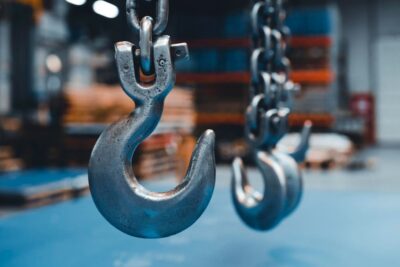Regarding heavy lifting in construction, shipping, mining, and manufacturing, chain slings are not just tools—they’re lifelines. They bear the burden of heavy loads, secure materials, and keep your operation moving efficiently. However, not all slings are created equal, and choosing the wrong one can lead to costly damage, serious safety risks, and production delays. Understanding the importance of selecting the right chain sling could be the difference between a seamless workflow and a serious operational setback.
Understanding What Chain Slings Are
Chain slings are flexible lifting devices made from high-grade alloy steel chains. They’re built to handle extremely heavy loads in rugged environments, often where synthetic slings would fail. Chain slings are a go-to in demanding workplaces thanks to their durability, abrasion resistance, and ability to withstand high temperatures. But choosing the right type and configuration is key.
Single-leg, double-leg, triple-leg, and quad-leg slings all serve different purposes, and the load requirements of your operation should dictate which one you use.
The Cost of Getting It Wrong
Using the wrong chain sling can result in more than just inefficiency. It can lead to dropped loads, damaged equipment, or worker injury. A minor mismatch—like choosing a sling with the wrong capacity or leg configuration—can cause a load to swing dangerously or become unbalanced during lifting. Not only does this put your equipment and products at risk, but it also opens the door to serious safety violations, lawsuits, and downtime. In today’s fast-paced industrial world, downtime is more than an inconvenience—it’s lost revenue.
Matching the Sling to the Job
Every lifting job has unique requirements. The load’s size, shape, weight, and the lifting environment all play a role in choosing the right sling. For instance, multi-leg slings are better for larger, bulkier items, while single-leg slings are best for smaller, concentrated loads. Chain slings also come with different hooks, master links, and adjustment features that can make a big difference. Taking the time to evaluate your operation’s specific lifting challenges is essential for long-term performance and safety.
The Role of Sling Grades and Capacity
Chain slings are classified by grade, with Grade 80 and Grade 100 being the most common in industrial settings. These grades relate to the strength and durability of the chain, with higher numbers indicating higher tensile strength. Overloading a chain sling beyond its rated capacity can lead to catastrophic failure. It’s crucial to know your sling’s working load limit (WLL) and ensure that it exceeds the maximum weight of the lifted load.
Environmental Considerations Matter
Certain environments pose extra challenges to lifting equipment. Extreme temperatures, moisture, chemicals, and UV exposure can degrade materials. Unlike synthetic slings, chain slings perform exceptionally well in high-heat and abrasive conditions. However, even metal can corrode or weaken under the wrong conditions. Selecting a chain sling with the right protective finishes or coatings can help extend its lifespan and maintain safety standards.
Regular Inspection and Maintenance are non-negotiable.
Even the highest quality chain sling can fail without regular maintenance. Chains must be inspected frequently for wear, elongation, cracks, and deformation. Neglecting to check your gear can result in unexpected failure when you need it most. Implementing a rigorous inspection protocol, including visual checks before every lift and scheduled detailed inspections, can prevent incidents and maintain compliance with safety regulations.
Training Your Team on Proper Use
Even the right sling can become a hazard in the wrong hands. Your team must be trained in operating chain sling, identifying wear, correctly attaching loads, and calculating safe load limits. Operator training is vital to keeping your operation productive and safe. Mistakes due to improper use can lead to sling failure, accidents, and liability issues—none of which you want on your work site.
Why Investing in Quality Chain Slings Pays Off
It might be tempting to choose the cheapest option, especially when ordering equipment in bulk. But when it comes to chain slings, quality should never be compromised. Investing in top-grade, properly rated slings may cost more upfront, but it will save you money in the long run through reduced downtime, fewer accidents, and longer-lasting equipment. Think of it as investing in your operation’s future.
Customization for Specific Applications
Not every operation can rely on standard, off-the-shelf slings. Many industries require custom-built chain slings tailored to their specific lifting needs. WCustom solutions can be engineered for better safety and efficiency, whether it’s unusual load shapes or extreme working conditions; collaborating with a reputable sling manufacturer or supplier can give you access to tools precisely suited to your application.
Safety Compliance and Industry Standards
Chain slings are subject to various regulations and safety standards, including OSHA, ASME, and other industry-specific guidelines. Staying compliant means staying informed. Regular documentation, equipment certification, and adherence to operational standards are all part of the equation. Failing to meet these standards doesn’t just pose safety risks—it can lead to fines, shutdowns, and long-term reputational damage.
Selecting the right chain sling is more than a practical decision—it’s a strategic move that protects your people, safeguards your equipment, and keeps your operation running at peak efficiency. With the right sling in place, you reduce the risk of accidents, improve productivity, and avoid costly downtime. Don’t leave it to guesswork or convenience. If you’re ready to make smarter, safer choices for your lifting operations, check out SlingSmarter for expert guidance and high-quality solutions that match your needs. Your operation deserves the best, starting with choosing the right tools.
View the original article and our Inspiration here


Leave a Reply